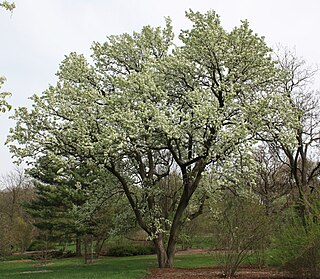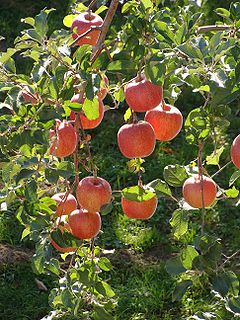| Seckel pear | |
|---|---|
 | |
| Genus | Pyrus |
| Species | Pyrus communis |
| Hybrid parentage | wild seedling |
| Cultivar | Seckel |
| Origin | Pennsylvania |
The Seckel pear (or sugar pear) is a small, very sweet cultivar of pear believed to have originated in Pennsylvania.
| Seckel pear | |
|---|---|
 | |
| Genus | Pyrus |
| Species | Pyrus communis |
| Hybrid parentage | wild seedling |
| Cultivar | Seckel |
| Origin | Pennsylvania |
The Seckel pear (or sugar pear) is a small, very sweet cultivar of pear believed to have originated in Pennsylvania.

The Seckel is said to be named after the Pennsylvania farmer who first introduced it in the late 18th century. [1] It was one of the varieties planted at Monticello by Thomas Jefferson, who said it "exceeded anything I have tasted since I left France, and equalled any pear I had seen there." His high regard for the Seckel was shared by the eminent horticulturalist A. J. Downing, who rated its flavor above even European pear varieties. [2]
The Seckel pear tree is relatively small, reaching a height of 15-20 feet and width of about 10 feet. [3] It has light grey bark and resembles an apple tree. [4] Its white flowers bloom in mid-Spring. [3] The tree is cold-hardy, frost-resistant, and resistant to fire blight. [4]
The Seckel is a winter pear, harvested in the fall, which can be stored for about 5 months. The fruit is very sweet and crunchy, with a coarser grain than most European varieties. [5] Compared to most other pears, they are very small, less than 3" in length and width. [4]

Pears are fruits produced and consumed around the world, growing on a tree and harvested in late Summer into October. The pear tree and shrub are a species of genus Pyrus, in the family Rosaceae, bearing the pomaceous fruit of the same name. Several species of pears are valued for their edible fruit and juices, while others are cultivated as trees.

The chestnuts are a group of eight or nine species of deciduous trees and shrubs in the genus Castanea, in the beech family Fagaceae. They are native to temperate regions of the Northern Hemisphere.

Fruit tree propagation is usually carried out vegetatively (non-sexually) by grafting or budding a desired variety onto a suitable rootstock.

Prunus cerasus is a species of Prunus in the subgenus Cerasus (cherries), native to much of Europe and southwest Asia. It is closely related to the sweet cherry, but has a fruit that is more acidic. Its sour pulp is edible.

Carambola, also known as star fruit or starfruit, is the fruit of Averrhoa carambola, a species of tree native to tropical Southeast Asia. The fruit is commonly consumed in parts of Brazil, Southeast Asia, South Asia, the South Pacific, Micronesia, parts of East Asia, and the Caribbean. The tree is cultivated throughout tropical areas of the world.
Perry is an alcoholic beverage made from fermented pears, similar to the way cider is made from apples. It has been common for centuries in England, particularly in the Three Counties ; it is also made in parts of South Wales and France, especially Normandy and Anjou. It is also made in Commonwealth countries such as Canada, Australia and New Zealand.

The persimmon is the edible fruit of a number of species of trees in the genus Diospyros. The most widely cultivated of these is the Oriental persimmon, Diospyros kaki. Diospyros is in the family Ebenaceae, and a number of non-persimmon species of the genus are grown for ebony timber. In 2019, China produced 75% of the world total of persimmons.

The quince is the sole member of the genus Cydonia in the family Rosaceae. It is a tree fruit that bears a deciduous pome fruit, similar in appearance to a pear, and is bright golden-yellow when mature. The raw fruit is a source of food. The tree has been grown by landscape architects for its attractive pale pink blossoms and other ornamental qualities.

Pollination of fruit trees is required to produce seeds with surrounding fruit. It is the process of moving pollen from the anther to the stigma, either in the same flower or in another flower. Some tree species, including many fruit trees, do not produce fruit from self-pollination, so pollinizer trees are planted in orchards.

The loquat is a large evergreen shrub or tree, grown commercially for its orange fruit and for its leaves for tea, and also cultivated as an ornamental plant.

Pyrus calleryana, or the Callery pear, is a species of pear tree native to China and Vietnam, in the family Rosaceae. It is most commonly known for its cultivar 'Bradford', widely planted throughout the United States and increasingly regarded as an invasive species.

The damson or damson plum, also archaically called the "damascene", is an edible drupaceous fruit, a subspecies of the plum tree. Varieties of insititia are found across Europe, but the name damson is derived from and most commonly applied to forms that are native to Great Britain. Damsons are relatively small ovoid plum-like fruit with a distinctive, somewhat astringent taste, and are widely used for culinary purposes, particularly in fruit preserves and jams.

Pyrus communis, known as the European pear or common pear, is a species of pear native to central and eastern Europe and southwest Asia.

The Fuji apple is an apple cultivar developed by growers at Tohoku Research Station (農林省園芸試験場東北支場) in Fujisaki, Aomori, Japan, in the late 1930s, and brought to market in 1962. It originated as a cross between two American apple varieties—the Red Delicious and old Virginia Ralls Genet apples. According to the US Apple Association website it is one of the fifteen most popular apple cultivars in the United States. Its name is derived from the first part of the town where it was developed: Fujisaki.

The orange is the fruit of various citrus species in the family Rutaceae ; it primarily refers to Citrus × sinensis, which is also called sweet orange, to distinguish it from the related Citrus × aurantium, referred to as bitter orange. The sweet orange reproduces asexually ; varieties of sweet orange arise through mutations.

Diospyros kaki, the Oriental persimmon, Chinese persimmon, Japanese persimmon or kaki persimmon, is the most widely cultivated species of the genus Diospyros. Although its first botanical description was not published until 1780, D. kaki is among the oldest cultivated plants, having been in use in China for more than 2000 years.

The Williams' bon chrétien pear, commonly called the Williams pear, or the Bartlett pear in the United States and Canada, is the most commonly grown variety of pear in most countries outside Asia.

Pyrus bourgaeana, the Iberian pear, is a close relative of Pyrus communis L. The last was domesticated about 2500 years ago. This monoecious small tree is widely distributed across the southern Iberian Peninsula and northern Morocco, where it coexists with four Pyrus species: P. communis L., P. cordata Dew., P. spinosa Forssk, and P. nivalis Jacq. Characteristics to discriminate these species are the width of fruit peduncle, petal size, leaf width and petiole length served to the taxa.

EverCrisp is an American apple cultivar developed by the Midwest Apple Improvement Association (MAIA). Trademarked as EverCrisp, the MAIA-1 variety is a cross between two existing apple cultivars – the Honeycrisp and Fuji. Originally produced in Ohio, EverCrisp has since expanded to apple-growing regions across the Midwest in Michigan, Illinois and Indiana, and in the Northeast in Pennsylvania and New York. The apple entered the public marketplace in 2017.

The Concorde is a cultivar of pear originating in England. A cross of the Conference and Comice varieties, it has some of the traits of both parents.